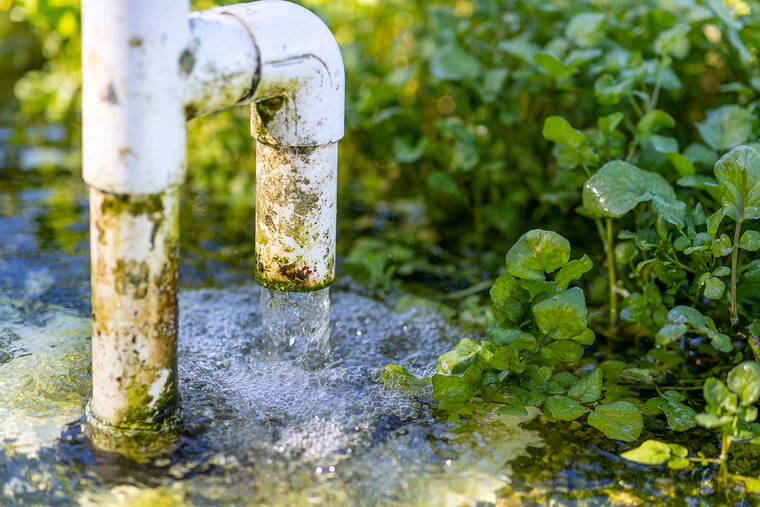Column: Water is precious resource for all of public to share

BRYAN BERKOWITZ / 2019
Watercress grows in water at Kulahaven Aquaponic Trout Farm in Kula.

COURTESY PHOTO
Joseph Archangel


Note: In the difficult months following the Aug. 8, 2023, wildfires that devastated Lahaina, education was disrupted significantly. But amid the struggles, students and educators persevered — and the learning and classwork resumed.
At Lahainaluna High School this past school year, teacher Jarrett Chapin tasked his English/Language Arts sophomores to research topics related to local problems and to write speeches, project proposals and op-eds about their issues.
Today, we present abridged versions of three of those pieces. All reflect the diligence, learning and critical thinking being done by Lahaina’s youth even as they, and their community, strive for recovery amid ongoing challenges.
It’s April of 2024 in Lahaina. A week’s worth of rain preserves the land and changes the dry landscape completely. As the rain disappears for a time, so does the beautiful, green landscape. Days go by and Lahaina gets dryer. But this is all just Lahaina’s regular routine — along with having one large fire almost every year due to a lack of water. All the locals that make Lahaina have gotten used to it. All they lose is their sense of safety, and maybe a house and a few loved ones.
This routine of off-and-on land preservation has been going on for years. There is no water to be found. Cultivating the land is impossible with the meager 13 inches of rain Lahaina gets a year. It’s only a matter of time until fires become more common and burn down Lahaina’s new town.
Lahaina used to be a wetland with plenty of water throughout the landscape. It gave life to Lahaina, provided for the people and maintained the land. “It was lush and green. Hundreds of ‘uli trees and native plants were found everywhere. Gentle flowing auwai systems flowed from the mountain to the sea to feed crops, taro patches, and Moku‘ula. It was like Heaven on Earth,” says Hawaiian Studies kumu, Jamie Palakiko. However, this healthy ecosystem and environment soon came to an end, once settlers and businessmen invaded the island.
Don't miss out on what's happening!
Stay in touch with breaking news, as it happens, conveniently in your email inbox. It's FREE!
The Pioneer Mill Co. was a plantation in Lahaina created in 1860. It grew to be 36,000 acres and diverted millions of gallons of water from six different streams: Kaua’ula, Kahoma, Launiupoko, Kanaha, Olowalu and Ukumehame. These diversions lasted for about 139 years until the plantation ended in 1999; the streams/ditch irrigation systems were then purchased by land developers.
Katie Roth and Ayron Strauch at the Maui County Water Commission note that this history makes up a huge part of our current problem as the plantations contributed to damaging the original soil structure in Lahaina. The removal of native vegetation and soil excavation, they suggest, may have “contributed to reductions in soil moisture or the ability for the soil to hold on to water. We have more intense runoff events, greater sediment transport, and it’s just reducing the length of time that any natural rainfall remains in the landscape.”
>> RELATED: Column: Rebuild coral reefs that help prevent coast erosion
>> RELATED: Column: Act on permanent housing solutions for local people
History has left Lahaina with few viable solutions. Roth and Strauch noted that, on one hand, water currently in the streams could be diverted. Yet, taking water from streams to grow plants and cultivate the land would reduce the amount of water that’s in the stream. On the other hand, taking it from the aquifers would reduce the amount of water, which is already limited and used to supply businesses, homes, hotels and golf courses.
Strauch noted that it might be possible, given the options, to recreate the green Lahaina of old by using “alternative water supplies” like water runoff captured in reservoirs or recycled or reclaimed water. These alternative systems could be distributed by using the infrastructure of the old plantations. This could help revegetate native species and make Lahaina green again.
While droughts seem to be a reoccurring problem in Lahaina, that never seems to be the case at hotels and golf courses a few miles away from town. The aquifers in Lahaina, which contain a limited amount of water, provide for residences, hotels and golf courses. So why don’t we tighten regulations on the water given to hotels and golf courses?
It’s possible that holding back some water used for hotels and golf courses could negatively impact tourism, our island’s biggest money maker. Yet, why should the town burn so that a few people can golf? Also, hotels and golf courses consume more water than they need to provide a beautiful environment for people who don’t even live in Lahaina. Some water should be going into cultivating our land for everyone to enjoy.
In some sense, the Lahaina wildfire began way back in 1738. As Johnathan L. Scheuer and Bianca K. Isaki have written, the diversion of water may be understood as an act of war. They begin their history of water use by recalling the story of Alapa’i, the Big Island warrior who decided to dam the streams in preparation for war against Maui. The monopolizing control of water resources by plantations, and now hotels, can be seen as “no less deliberate than what Alapa’i employed.” So let’s end this war that started hundreds of years ago and give back to our island and its locals. Water is a natural resource that belongs to all mankind. We should all be able to live in a beautiful, green and lush environment.
Joseph Archangel was a sophomore last year at Lahainaluna High School.



